
Trachycarpus, Chusan palm: planting, growing and care
Contents
Trachycarpus in a nutshell
- Trachycarpus is an elegant palm with a stipe covered in brown fibres
- It has a majestic form, with a slender, upright stipe from the top of which the foliage unfurls
- Its large, beautiful palmate leaves, fan-shaped, are much admired
- It is among the most hardy palms and can be planted in open ground even in cool regions
- It is resilient and very easy to grow
- Its single presence instantly brings a great deal of exoticism to the garden!
A word from our Expert
Also called hemp palm or Chinese palm, Trachycarpus is a superb hardy palm, with a fibrous, upright and slender trunk, at whose top majestic palmate leaves unfold. It is one of the most grown palms worldwide for its ornamental qualities. Species Trachycarpus fortunei is most common, but others are interesting to grow, such as Trachycarpus wagnerianus, slightly smaller with stiffer leaves. Trachycarpus resembles Chamaerops; it has same type of palmate foliage. However, it is much taller and more slender, whereas Chamaerops is small and grows in clumps, sometimes producing many shoots.
Trachycarpus has advantage of being very hardy. Capable of withstanding down to -18 °C, it can be planted even in north of France. It is a very versatile palm, adapting to different situations. Compared with other palms, it tolerates shaded conditions quite well – provided shade is not too dense – as well as full sun; it endures drought but also heavy, wet soils… Trachycarpus is not demanding, although it appreciates some care at planting and during first years.
If you want to know everything about palms, and discover many varieties, consult our factsheet “Palms: To plant, to grow and to maintain”
Description and botany
Botanical data
- Latin name Trachycarpus sp.
- Family Arecaceae
- Common name hemp palm, Chinese windmill palm
- Flowering generally between May and July
- Height up to 10 m
- Sun exposure sun or partial shade
- Soil type ordinary, preferably fresh and well-drained, humus-bearing
- Hardiness -18 °C
Trachycarpus is a majestic palm with a slender stipe covered in brown fibres and dark green, fan-shaped leaves. It is also called hemp palm or Chinese windmill palm. It originates from subtropical Asia: it occurs east of the Himalayas, in southern China, northern India and Thailand, in Burma and Nepal. In the wild it grows in forests, mainly in mountainous regions. It can be found up to 2,500 metres altitude. Thus, it tolerates cold well, which explains why it has become one of the most widely cultivated palms in gardens, adding an exotic touch even in cool regions. Trachycarpus has even naturalised in parts of Switzerland!
There are nine Trachycarpus species. T. fortunei is one of the most commonly grown palms in gardens in France, probably because it is very hardy, able to withstand down to –18 °C. It has been cultivated in Japan and China for a very long time and was introduced to Europe in the mid-19th century. A little less well known, Trachycarpus wagnerianus is also very interesting to grow. It is smaller and has somewhat stiffer leaves.
Etymologically, Trachycarpus owes its name to the Greek trachys: rough, and karpos: fruit. Species name fortunei honours English botanist Robert Fortune (1812–1880), who brought this palm from China to Europe in 1849. Trachycarpus is fairly close to Chamaerops, another fan-leaved palm. In fact, T. fortunei was formerly called Chamaerops excelsa.
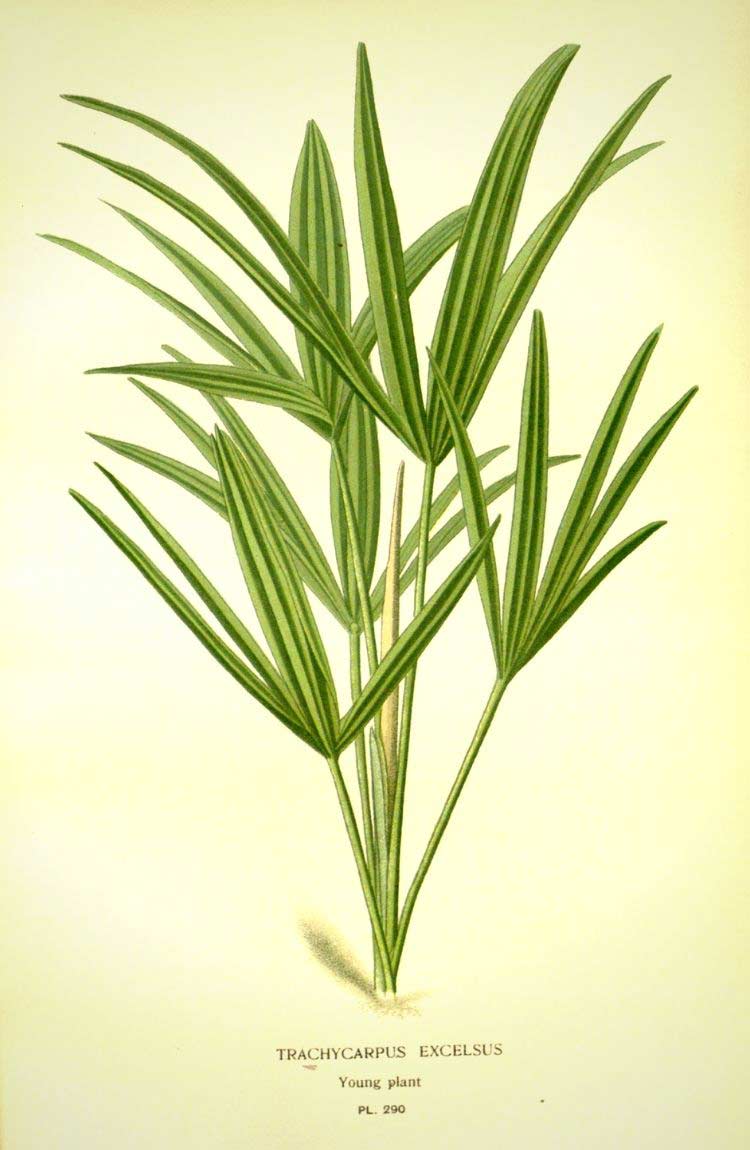
Trachycarpus excelsus: Botanical illustration
It belongs, of course, to the large palm family, the Arecaceae, which include more than 2,500 species. It shares with them a number of characteristics: a long, straight, unbranched stipe, topped by large, thick, leathery leaves cut into linear leaflets. Like other palms, Trachycarpus has a majestic, exotic appearance. A single specimen is enough to transform a garden. Its mere presence evokes travel at a glance. Palms are not trees. They do not produce wood, are not ramified, and their stipe does not really increase in diameter.
Trachycarpus has an elegant, slim silhouette, very upright. It grows fairly quickly compared with other palms. T. fortunei reaches up to 10 metres in height. T. wagnerianus is smaller, not exceeding 6 m in height, and is better suited to small gardens or container culture. However, the smallest species among these palms is Trachycarpus nanus.
Trachycarpus is not branched, but has a single, very straight, vertical stipe. A crown of leaves unfolds at the top of that stipe. The stipe becomes tall with time but does not thicken in diameter, unlike true trees. It is covered in brown fibres that help protect the trunk from cold and drought by forming an insulating layer. They give the stipe a hairy appearance. They are decorative, lending a “rustic” look. Sometimes, on older specimens, this fibrous layer can disappear, revealing a smooth stipe marked by regular rings. Trachycarpus with stripped stipes can be found in trade; however, this fibrous layer has a protective role for the palm, so it is always preferable to leave it in place.
Leaves of Trachycarpus are palmate, like those of Chamaerops (whereas other palms have, conversely, pinnate foliage, feather-shaped: Butia, Phoenix…). They are fan-shaped, thick, leathery and plicate.
They comprise between 30 and 50 long, narrow, linear segments that radiate from the petiole. Leaves of Trachycarpus fortunei measure up to 80 cm in length and are borne on a very long petiole (up to 1 m). This petiole bears no thorns, which distinguishes it from Chamaerops. The outline of Trachycarpus leaves is relatively rounded, forming an arc that is pierced by the dissection of the leaflets. The leaves have a majestic, impressive aspect.
Leaves of Trachycarpus wagnerianus are smaller, thicker and stiffer than those of T. fortunei. These characteristics make them more resistant to strong winds.
Leaves are renewed progressively, new ones appearing from the centre of the crown. Old leaves dry and fold against the trunk, thus forming a skirt. They help protect the palm from cold.
Leaves of Trachycarpus are generally dark green; however, Trachycarpus princeps has bluish fronds. The leaves are, of course, evergreen: they remain in place over winter.

Stipe and foliage of Trachycarpus (photos KENPEI / Vera Buhl)
Like other palms, Trachycarpus has fine, fairly long roots. They are very different from tree roots and are unlikely to cause damage to structures if the palm is planted nearby, but we nevertheless advise against planting it too close to a wall; give it room to develop.
Trachycarpus flowers in spring, around June. It then bears large yellow inflorescences in panicles. These inflorescences arise at the axils of the leaves; they remain fairly close to the stipe. They are ramified and measure up to 80 cm in length. Female inflorescences are larger and less compact than male ones. The flowers forming the inflorescences are small and very numerous, composed of three sepals and three petals. Male flowers have six stamens that release pollen to fertilise female flowers on another plant. Indeed, Trachycarpus is dioecious: each plant is either female (bearing only female flowers) or male. Flowers are bright yellow on male plants and paler, cream-yellow, on female individuals.

Inflorescences and fruits of Trachycarpus fortunei (photo Ji-Elle / Père Igor)
After flowering, on female plants small globose fruits appear, first green then turning bluish-black when ripe. They are numerous and gathered in clusters. They measure up to 1 cm in length. They enable seed dispersal thanks to birds that eat the fruits.
Main varieties of Trachycarpus
Most popular varieties
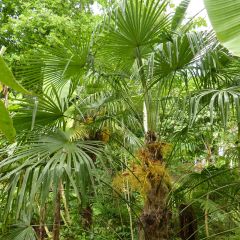
Trachycarpus fortunei - Chinese Windmill Palm
- Flowering time August to October
- Height at maturity 8 m
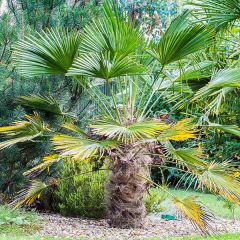
Trachycarpus wagnerianus - Dwarf Chusan Palm
- Flowering time July, August
- Height at maturity 6,50 m
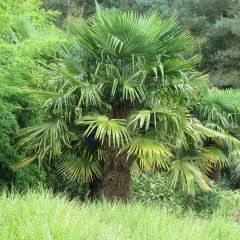
Chusan palm Seeds - Trachycarpus fortunei
- Flowering time August to October
- Height at maturity 8 m
Discover other Trachycarpus
View all →Available in 1 sizes
Available in 2 sizes
Available in 4 sizes
Available in 1 sizes
Planting
Where to plant Trachycarpus?
Trachycarpus will thrive in sun or partial shade. Contrary to what one might think, it does not necessarily need full sun… in its native habitat it actually grows mainly in forest. If you live in southern France, you can easily site it in dappled shade, whereas in regions north of the country it is better to plant it in sun. Most important is to avoid dense shade. Preferably place it sheltered from strong winds, which can tear its foliage. However, Trachycarpus wagnerianus, with its smaller, stiffer fronds, is less sensitive to wind than T. fortunei.
It is not demanding about soil type and can grow on most ground. It will, however, appreciate a humus-bearing substrate rich in organic matter and relatively moist conditions. It also grows well in clay and heavy soils.
You can plant Trachycarpus as a specimen, in a row, or at the back of a border. Feel free to plant it in a small group of three or five palms to create a little grove.
Trachycarpus can adapt to planting in a large pot or container, but in that case choose Trachycarpus wagnerianus rather than T. fortunei. Trachycarpus will, however, prefer to be planted in open ground in the garden. As it tolerates down to −18 °C, it can be planted almost anywhere, even if you live in a cold or mountainous area. It adapts to a great diversity of situations: sun or partial shade, fresh or drier soil… It is a palm that can be established in many gardens!
When to plant?
Best time to plant Trachycarpus is spring, around May. This is when temperatures start to moderate and it will have time to establish well before facing winter cold the following year.
How to plant?
Do not hesitate to plant Trachycarpus in small groups, for example in threes, for a dense, natural effect.
- You can start by placing the rootball in a container filled with water to rewet it and make later watering easier.
- Dig a large planting hole, at least twice the volume of the rootball.
- If necessary, add draining materials: gravel, coarse sand…
- Take your palm out of its pot, loosen the rootball slightly, then place it in the planting hole.
- Backfill soil all around.
- You can make a watering basin by digging slightly around the stipe.
- Water well.
It is best to continue watering in the weeks following planting, while the palm develops its root system.
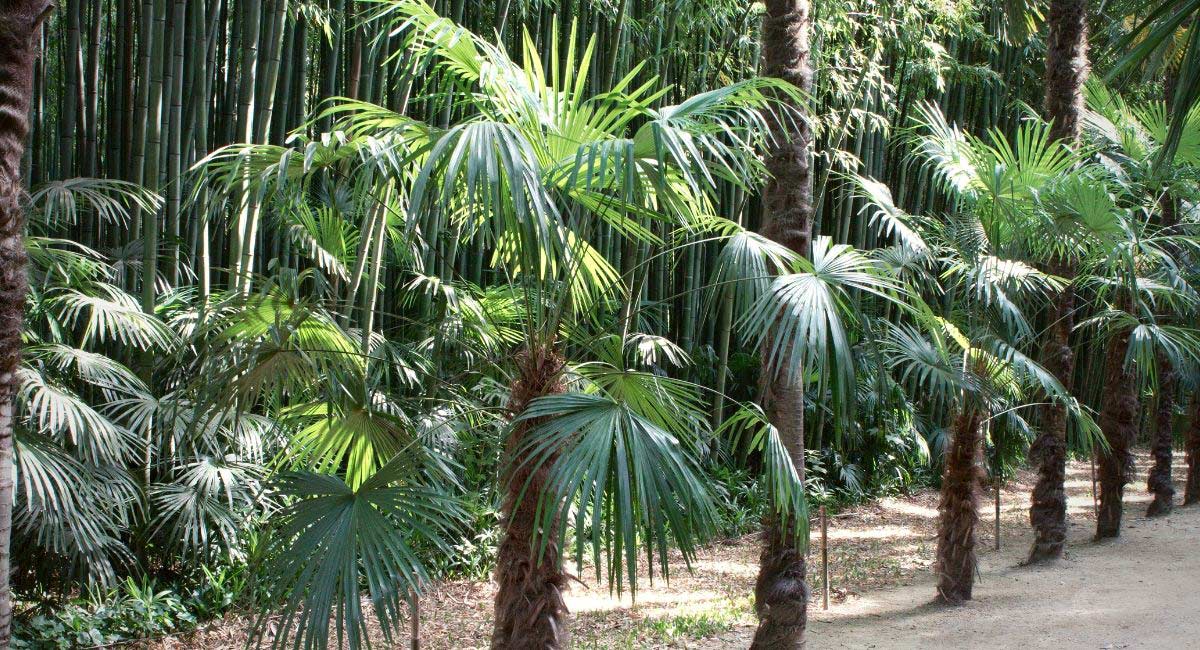
An avenue of Trachycarpus fortunei at Bambouseraie d’Anduze (photo Georges Seguin)
Windmill palm care
Trachycarpus requires very little care. It is not a difficult plant: it can tolerate, to some extent, cold, heat, lack and excess of water. It can grow in a range of soils, and even accepts growing in shade, provided it is not too dense. If you live in a cold area, during first years you can protect palm from cold by wrapping it in a winter fleece or by bringing it under cover if it is in a pot. Over time it becomes more frost‑hardy.
Like many other palms, Trachycarpus tolerates drought fairly well. However, it prefers cool soil, which is why we advise watering during first year, then in case of drought. Feel free to apply mulch around its base to keep soil cool, using for example ramial chipped wood, wood chips, dead leaves, straw… In general, Trachycarpus does not usually need fertiliser.
You can prune old dried fronds, however it is preferable to leave them as they provide protection for palm. If you choose to cut them, do so in spring.
If you grow it in a pot, remember to repot Trachycarpus from time to time into a slightly larger pot, to give it more space and renew its substrate. Once you have reached a maximum pot size, you can carry out only top‑dressings, superficially replacing potting compost in the top few centimetres.
As with other palms, the two main pests that cause problems for Trachycarpus are the palm moth Paysandisia archon and the red palm weevil. The palm moth lays its eggs near crown of leaves, then larvae enter the stipe and feed on it from the inside. This causes deformation and perforation of fronds, which sometimes dry out. This pest causes heavy damage to palms, as does the red palm weevil, whose larvae consume young fronds and the interior of the stipe. It is possible to treat using a nematode‑based solution. Do not hesitate to call in a professional.
Propagation: sow a Trachycarpus
It’s fairly easy to propagate Trachycarpus by sowing seeds. However, you will have to wait a long time to obtain fine specimens with a well-developed stipe. Carry out sowing preferably in spring. Fresh seeds germinate more easily and more quickly.
- Place seeds in a glass filled with hot water for three days (change water every day).
- Prepare a pot with potting compost mixed with a little sand.
- Take seeds out of the water, rinse them, then sow them placing them about 1 cm deep.
- Press down very lightly.
- Water gently.
- Place the pot in a sheltered spot at a temperature between 20 and 24 °C, in a bright position but out of direct sun.
Ensure substrate remains slightly moist until germination. Be patient: seeds can take three months to germinate. When seedlings are large enough to handle, prick them out into individual pots, then, after three or four years, in spring, plant out in their final position.
Companion planting in the garden
Trachycarpus is ideal for creating a lush, exotic corner in the garden! Create an exotic feel by planting it with other plants with generous, unusual foliage: Gunnera manicata, Persicaria polymorpha, arborescent ferns, Datisca cannabina, etc. These exuberant leaves will help create a nice jungle effect! Don’t hesitate to plant some climbers, such as Akebia or trumpet creeper. You can also include bamboos. For flowering, choose for example Kniphofia, Lantana or Crocosmias. Preferably opt for flowers in warm tones, for example yellow, orange, red… Shades that catch the eye and bring dynamism to the garden. If you live around the Mediterranean, you can grow the Strelitzia reginae, which offers a striking orange-and-blue flowering, whose tapered petals evoke a bird.
If you want an exotic atmosphere and live in a cooler climate region, note that there are a few other hardy palm species: Nannorrhops ritchiana, Rhapidophyllum hystrix, Sabal minor… You can easily plant them alongside Trachycarpus. In a similar exotic style, discover arborescent ferns, for example Dicksonia antarctica.
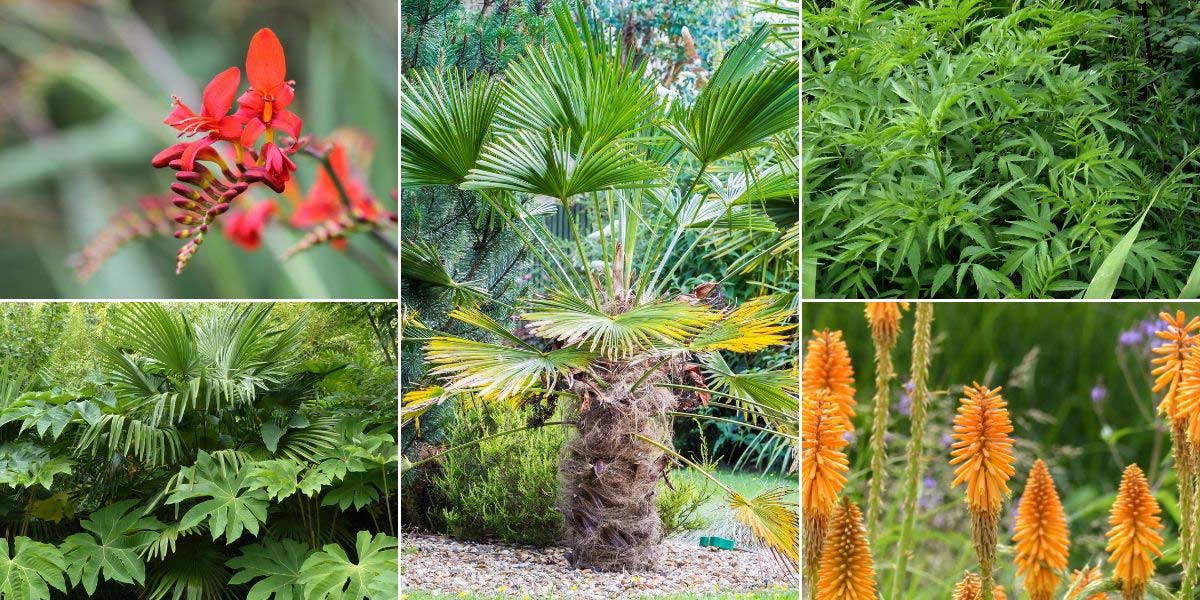
An example of an association for an exotic ambience: Crocosmia / Trachycarpus and Tetrapanax papyrifera ‘Rex’ / Trachycarpus wagnerianus (photo Simon Thomas) / Datisca cannabina (photo Peganum) / Kniphofia ‘Fiery Fred’
Trachycarpus can easily be integrated into a Mediterranean-style garden. Place it, for example, at the back of a border, behind lavender, Stachys byzantina, euphorbias, sedums… Add colour with helianthemums, oleanders, rockroses, Verbena bonariensis, Lantana… Also consider the superb flowering of the bougainvillea, a vigorous climber whose bracts impress with vivid colours. Very mineral in character, this garden style also has the advantage of being water-efficient, relatively eco-friendly, and requiring little maintenance.
With its very straight trunk, exotic appearance and graphic fronds, Trachycarpus will also find its place in a contemporary garden. You can plant nearby ornamental grasses such as Pennisetum or Stipa pennata, together with Agapanthus, Alliums, Ophiopogon planiscapus ‘Nigrescens’, Hostas… Create an atmosphere in fairly neutral, understated tones: purple, black, white, chocolate, silver-grey…
Did you know?
- Traditional uses
Fibres covering the trunk are harvested in China to make ropes, brushes, brooms, sacks and coarse, rough fabrics. They are durable and thick.
Useful resources
- Our Trachycarpus range
- Discover our full range of palms: Trachycarpus, Chamaerops, Butia, Phoenix, Washingtonia…
- If you would like more information on palms and how to grow them, consult our advice sheet “Palms: planting, growing and maintaining”
- Discover the website of the association Fous de Palmiers as well as the site of La Palmeraie, with lots of information on palms and how to grow them
- Our advice sheet: Palms by climate
- Discover our tutorial: How to dry a palm leaf?
- To prevent and treat: Diseases and parasitic pests of palms
Frequently asked questions
-
Should I cut off old leaves that have dried out?
With Trachycarpus palms, the oldest leaves eventually die and dry out while remaining attached, thus forming a sort of "skirt" beneath the crown of still‑living leaves. You can cut these old leaves for aesthetic reasons, to achieve a "neat" appearance, but we recommend leaving them in place. They form an insulating layer that protects the palm from cold, parasitic pests and other external threats.
-
Why are fronds perforated?
If holes are regular and in a line, your palm has probably been attacked by the palm butterfly, Paysandisia archon. The female lays her eggs near the crown of leaves, then the larvae enter the stipe and feed on it from the inside. This pest causes significant damage to several palm species. You can spray a nematode-based solution containing nematodes parasitic to these larvae, or call in a professional.
-
Palm fronds are turning yellow. Why?
Yellowing of foliage is probably caused by excess moisture. Grow it in a more free-draining substrate and reduce watering. It may also be due to a nutrient deficiency. We recommend applying a small amount of fertiliser.
-
Fronds are drying out! What can I do?
If it's only the outer, lower leaves — and the others remain intact — this is a natural phenomenon: palm tree simply renews its foliage. However, leaf drying can also be caused by lack of water, especially if bush is in a pot. Don't hesitate to water during prolonged dry spells. Finally, leaves can also dry out due to attack by red palm weevil or palm moth. Check that your palm tree shows no signs of their presence (perforated or deformed leaves, sawdust, tunnel holes...).
- Subscribe!
- Contents
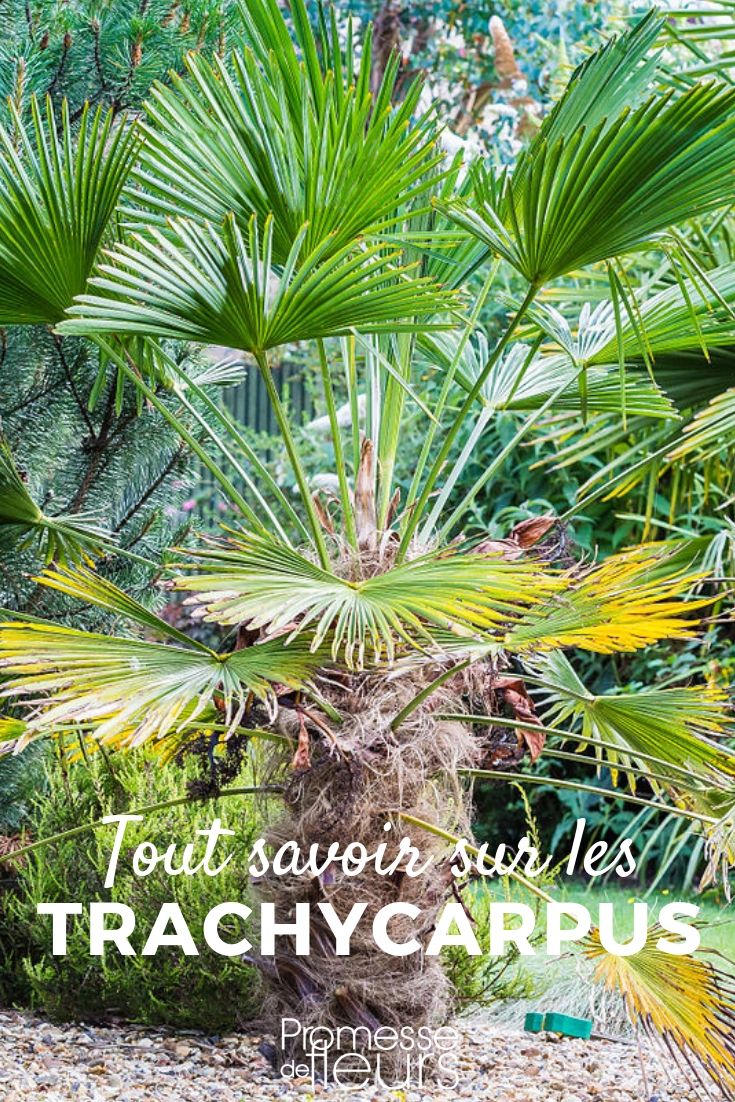



































Comments